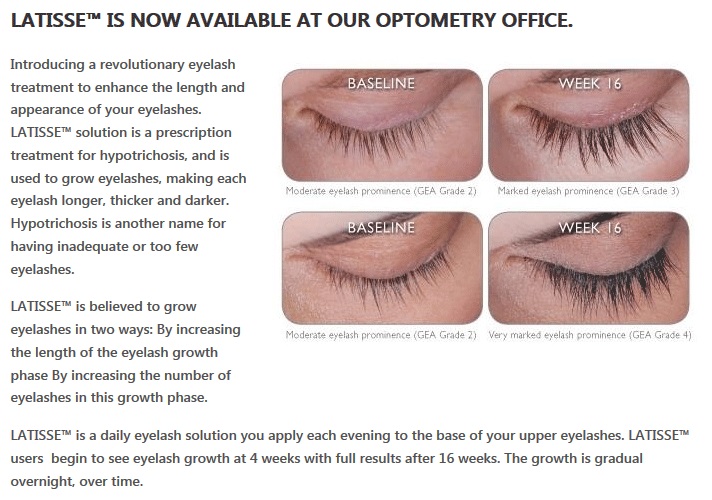By Diane Palombi, OD
As optometrists, we have education and training that gives us insight about the effect cosmetic procedures can have on the eyes. We also are sometimes able to be part of the cosmetic enhancement process with some states permitting ODs to write prescriptions for eyelash extension medication Latisse, and some states even permitting ODs to administer Botox.
But before you begin providing cosmetic treatments, or advising patients on the impact a cosmetic procedure may have on their eyes, consider whether you feel this is an appropriate role for an optometrist to play, and how you can do it in a way that benefits both patients and your practice.
Optometry has always been involved in the cosmetic industry. We have had designer eyeglass frames for decades now. For those who did not like the aesthetics of eyeglasses, contact lenses became available, which evolved into cosmetically tinted contact lenses that even patients without visual problems desired. The initial lenses were color enhancing lenses, which eventually became iris color changing lenses. Then came the refractive surgeries, radial keratometry, PRK and LASIK, designed to free patients from the need to wear glasses.
Technology is now moving optometry into a new area of opportunity: “cosmetic optometry.”

Some states permit ODs to prescribe Latisse, a medication that can darken and lengthen eyelashes. The above photo is from the web site of Eastside Optometric, a practice located within a LensCrafters in New York City.
For example, recently my girlfriends and I were discussing cosmetic procedures when I mentioned that I was considering having eyelash extensions placed on my outer lashes. They were surprised that I just didn’t write myself a prescription for Latisse since I am an optometrist. I then had to inform them that Latisse was originally a glaucoma medication where lash growth was a side effect. It could possibly darken not just the skin by my lashes, a fact that they were aware of, but also my blue eyes, which came as a surprise to them.
Then we talked about the over-the-counter anti-wrinkle treatments I use to reduce my wrinkles. Again they wondered why I didn’t go the Botox route. I explained that with my luck the toxin would seep into my eyelid giving me a droopy lid for months. They did not know that this rare side effect could possibly happen.
This discussion got me thinking that as optometrists we perhaps should consider informing our patients of the pros and cons of cosmetic procedures. Some of these procedures are even performed by non-medical personnel. In certain states optometrists can perform these procedures.
Mind Your Scope of Practice & Educate Patients of Risks
State law regulates what procedures optometrists can perform.
For instance, for Latisse, there are four basic categories of scope of practice for ODs, which varies state-by-state:
1. The optometrist can prescribe and dispense.
2. The optometrist can only prescribe. The doctor cannot dispense or sell it on retail.
3. With states with formularies, the state board of optometry may need to approve adding Latisse to the formulation before an optometrist can prescribe it.
4. The optometrist cannot prescribe the drug.
Even though an optometrist can prescribe Lumigan, the glaucoma medication, which is the same formulation of Latisse, state law could forbid him or her from prescribing Latisse.
Latisse is a version of the glaucoma medication, bimatoprost. It increases lash length, thickness and darkness. There are points that you need to inform your patients about concerning Latisse. First, it is not cheap and the results are not permanent. It can take two months to see the first changes, and four months to experience the full effects. If discontinued, the lashes return to normal. Patients should expect to spend $1,000- $2,000 per year on the drug. Insurance usually does not cover Latisse.
Common side effects are hyperemia, ocular itching, skin hyperpigmentation and permanent iris darkening. In your glaucoma patient, they could experience a decreased IOP lowering effect of their glaucoma medication if it is Lumigan or another prostaglandin. You must use caution prescribing Latisse for patients with uveitis. Macular edema risk patients, like aphakes, or pseudophakics, with torn or lazared posterior capsules, also need to be closely monitored.
Similar to Latisse, some state optometry laws permit optometrists to administer Botox injections. Botox is the botulinum toxin. The effects last around three months, so it is great repeat business. Botox has only one approved cosmetic use, which is on the glabellar area. When it is used on the forehead, crow’s feet, or other areas, it is considered off-label use.
Like Latisse, use of Botox requires caution in prescribing, and patient education. It is contraindicated in pregnant or lactating women. In addition, it has a relative contraindication in disorders of neuromuscular disorders like myasthenia gravis, disorders of muscle weakness and concomitant use of aminoglycoside antibiotics. Aspirin, ginkgo biloba, or any other anticoagulated, must be discontinued before the injection because it makes the patient susceptible to bruising. The patient should know there are are also counterfeit Botox on the market which can cause paralysis.
Then there are dermatological “fillers,” which ODs are not permitted to inject into patients. But patients may come to the OD will questions on how these procedures, administered around the eyes, might affect their eyes. With the exception of Radiesse, fillers last longer than Botox, usually a year or more, and are temporary and reversible.
Fillers should be injected by a surgeon with expertise on how much, and where, the filler needs to be injected. We have all seen bad results from the use of fillers. If nothing else, a patient who mentions the plan to have an injection around their eyes by a dermatologist or plastic surgeon, should be directed to have a conversation with their doctor on the possible risks, and the potential for the outcome not to be what they expected.
Scope of Practice May Be Expanding Into Greater Cosmetic Optometry
Bills in the state legislatures are being introduced to expand the range of optometry from minor surgeries, such as removing skin tags from the lid, to performing laser surgeries. We are more qualified than a patient’s primary care doctor to prescribe, or administer, these procedures. In addition, we are more suited to treat the common side effects, which are often ocular-related.
I am retired, but when I was still in practice, I sent patients out for blepharoplasties when their lids drooped to the level that it showed up on a visual field. Occasionally I discussed Latisse, but only when the patient brought it up first. I normally would not consider a discussion of cosmetic procedures part of my routine exam.
However, many of us Baby Boomers do not embrace the natural aging process, with many of us interested in looking younger longer.
Optometrists should be more proactive in discussing eye-related cosmetic procedures with our aging patients. We can give an unbiased opinion since we are not profiting from many, if not most, of the procedures. If our state optometric laws permit us to perform the procedures, we have another avenue to grow our practices. Patients are motivated by the desire to look young, and feel good about their appearance, and we can capture some of that market.
The key is ensuring you prescribe, and perform, only those cosmetic medications or treatments legally permitted to you, and that you fully educate patients of both the benefits and risks.
Do you practice “cosmetic optometry” in your practice? What cosmetic-related medications and procedures do you feel are appropriate for ODs to participate in? Is this a practice-building opportunity, or an area of practice that ODs should stay away from?
 Diane Palombi, OD, retired now, is the former owner of Palombi Vision Center in Wentzville, Mo. To contact her: dlpod1@hotmail.com
Diane Palombi, OD, retired now, is the former owner of Palombi Vision Center in Wentzville, Mo. To contact her: dlpod1@hotmail.com



























